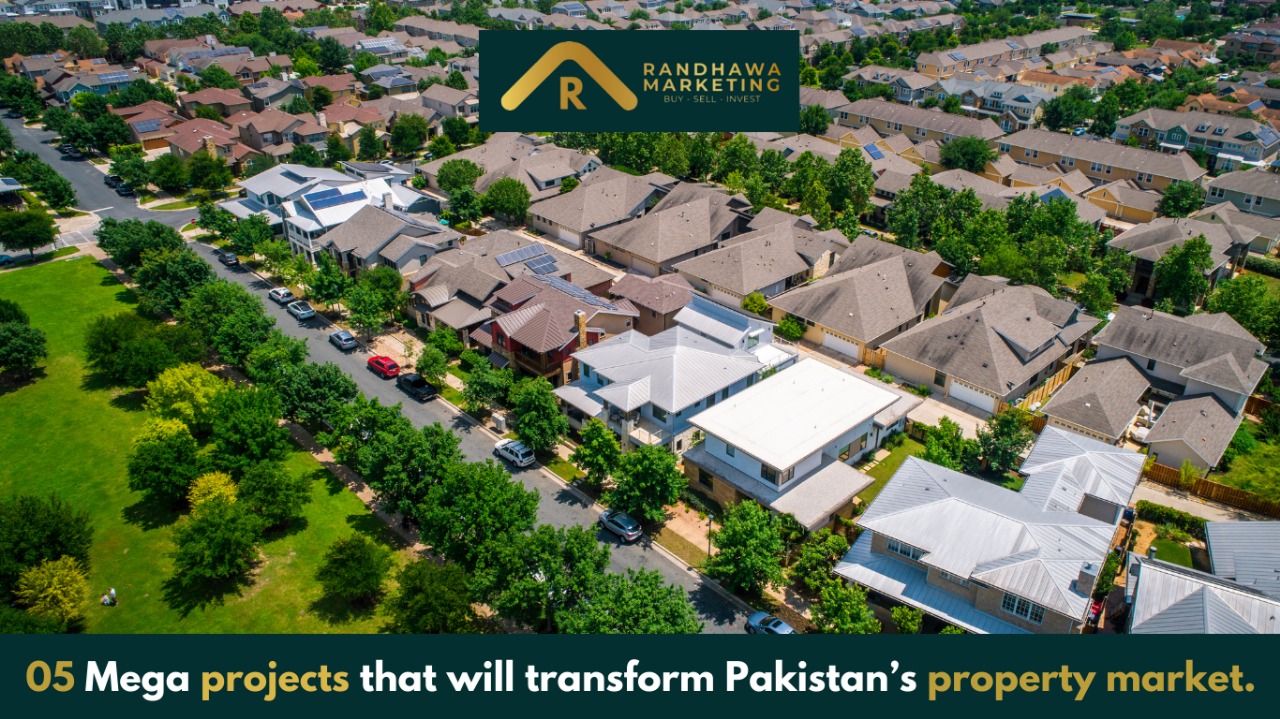
5 Mega Projects That Will
Transform Pakistan’s Property Market
Pakistan’s real estate sector is
standing at a turning point. For years, the market has been shaped by traditional
housing schemes and scattered urban expansion, but now a new wave of mega
projects is setting the stage for something bigger. These developments are not
just about building homes or commercial plazas they are about reshaping entire
cities, improving connectivity, and aligning Pakistan with global urban and
economic trends. One of the most significant drivers of this change is
infrastructure. Motorways, ring roads, and new international airports are
reducing distances between major cities and opening up previously inaccessible
areas for investment. At the same time, projects like Ravi City in Lahore and
Gwadar’s Smart Port City are introducing modern urban planning concepts that
focus on sustainability, technology, and smart living. Together, they are pushing
the real estate industry toward greater sophistication and long-term growth.
For investors and homebuyers
alike, this transformation means opportunity. Locations once considered
far-flung or underdeveloped are quickly turning into hotbeds of real estate
activity. Developers are expanding projects near these mega initiatives, while
overseas Pakistanis and institutional investors are eyeing them as
high-potential ventures. In short, these upcoming projects will not only change
the physical landscape of the country but also redefine how property ownership
and investment are perceived in Pakistan.
1. Motorways
Expansion (ML-1 & National Highways Network)
Pakistan’s
motorway and highway expansion has become one of the most influential drivers
of real estate development in recent years. The construction of new routes and
the up gradation of existing ones are gradually stitching together the
country’s urban and rural landscapes. Areas that were once considered remote or
difficult to access are now directly connected to major metropolitan cities
like Lahore, Karachi, Islamabad, and Peshawar. This improved accessibility is
not only reducing travel time for commuters but also unlocking new corridors of
growth for housing, trade, and industry.
A flagship
part of this transformation is the ML-1 Railway Project, a
multibillion-dollar venture under CPEC that will modernize the railway line
stretching from Karachi to Peshawar. Once completed, ML-1 will allow high-speed
trains to transport passengers and cargo more efficiently, complementing the
motorway network. Together, these projects will establish a seamless transport
system that supports both domestic connectivity and international trade.
The
impact on real estate is already visible. Secondary cities such as Faisalabad,
Multan, Sukkur, and Bahawalpur are witnessing increased investor interest as
developers launch new housing societies and commercial hubs near motorway
interchanges. Industrial zones are also being established along these routes,
creating demand for warehouses, logistics centers, and worker housing.
Infrastructure such as service areas, hospitals, schools, and retail outlets
tends to follow, giving rise to fully developed communities around motorway
corridors.
The expansion of the motorway and national highways network is not just
a transport initiative it is a foundation for urban growth, regional
integration, and sustainable real estate opportunities. Areas near
interchanges, bypasses, and railway links are emerging as high-potential
investment zones, offering both short-term gains and long-term value
appreciation.
2. New
International Airports (Islamabad & Gwadar)
Airports
have always played a central role in shaping the growth of cities, and
Pakistan’s latest aviation projects are no exception. The Islamabad
International Airport, inaugurated in 2018, is the country’s largest and
most modern airport. Spread across thousands of acres, it was designed with
future expansion in mind, featuring multiple runways, cargo facilities, and a
passenger capacity of over 15 million annually. Its presence has already
transformed the surrounding region. Areas that once consisted of agricultural
land and small villages are now thriving with housing schemes, commercial
plazas, hotels, and business hubs, catering to both travelers and investors.
On the
other hand, the Gwadar International Airport, which is under
construction with Chinese assistance, is expected to be a true game-changer for
Pakistan’s southwestern region. As the largest airport in Balochistan and one
of the biggest in South Asia once completed, it will directly support Gwadar’s
transformation into a global port and
trade city. The airport will handle heavy cargo planes and international
flights, linking Gwadar with the Middle East, Central Asia, Africa, and beyond.
This connectivity will not only boost tourism and trade but also make Gwadar a
magnet for real estate investors seeking opportunities in residential,
hospitality, and commercial developments.
The
infrastructure surrounding both airports is also expanding rapidly. In
Islamabad, wide expressways, metro bus extensions, and ring roads are
connecting the airport with the twin cities and beyond. Housing societies like
Top City, Mumtaz City, and Capital Smart City are thriving due to their proximity
to the airport, offering modern living options and high investment returns.
Similarly, in Gwadar, the airport is being integrated with new highways, the
East Bay Expressway, and industrial free zones, ensuring smooth access for
logistics, businesses, and future residents.
For
the real estate sector, international airports create ripple effects that
extend far beyond aviation. They generate demand for hotels, shopping malls,
warehouses, and residential complexes, while also pushing land prices upward in
surrounding areas. In both Islamabad and Gwadar, these airports are laying the
groundwork for entirely new real estate corridors that will redefine the
country’s urban and economic landscape in the years to come.
3. Ravi
Riverfront Urban Development Project (Ravi City, Lahore)
The Ravi
Riverfront Urban Development Project, commonly known as Ravi City,
is one of the most ambitious urban planning initiatives ever undertaken in
Pakistan. Envisioned as a modern and sustainable city along the banks of the
Ravi River, the project aims to ease the burden on Lahore, which has long been
struggling with overpopulation, traffic congestion, and unplanned urban sprawl.
Designed to rival global waterfront developments, Ravi City is often described
as Pakistan’s answer to Dubai’s urban model.
The project
covers more than 100,000
acres of land, divided into multiple phases, and will host
residential neighborhoods, commercial districts, industrial zones, and
recreational spaces. At its core is the idea of building a smart and
sustainable city that integrates technology, energy efficiency,
and eco-friendly practices. Plans include modern housing societies with advanced
infrastructure, business hubs designed for both local and international
companies, and entertainment districts to enhance urban living standards.
One
of the key features of Ravi City is its water management system,
which will revive the dying Ravi River through modern treatment plants,
reservoirs, and canals. This not only addresses Lahore’s water scarcity issue
but also creates scenic waterfronts that will add real estate value. Green
belts, parks, and eco-friendly zones are also part of the plan, ensuring that
residents enjoy a healthier environment compared to the congested neighborhoods
of old Lahore.
In
terms of infrastructure, the city will be equipped with state-of-the-art transport networks, including wide boulevards, metro and
bus connections, and ring road linkages to provide seamless connectivity with
Lahore and surrounding regions. Dedicated industrial and technology parks will
support job creation and business growth, while modern schools, hospitals, and
shopping complexes will provide world-class facilities to residents.
From
a real estate perspective, Ravi City is being seen as a once-in-a-lifetime
opportunity. With plots available for residential, commercial, and mixed-use
developments, the project is attracting strong interest from both local and
overseas Pakistanis. Its master-planned design ensures that property values are
likely to appreciate significantly once the first phases become operational.
In
essence, Ravi City is not just a housing project—it is the blueprint for a new
urban future in Pakistan. By combining sustainability, modern infrastructure,
and international design standards, it has the potential to transform Lahore
into a regional hub for investment, business, and quality living.
4. Gwadar Smart
Port City
Gwadar is
often described as the crown jewel of the China-Pakistan Economic Corridor (CPEC),
and for good reason. Strategically located along the Arabian Sea, Gwadar is
being developed into a world-class smart port city
that will serve as a hub for international trade, logistics, and investment.
Its master plan envisions transforming what was once a small fishing town into
a vibrant urban and economic powerhouse, comparable to global port cities like
Dubai and Singapore.
The Gwadar Smart Port City Master Plan outlines a comprehensive development
strategy that covers every aspect of modern urban living. It includes
residential zones with modern housing schemes, commercial areas for retail and
business activities, industrial estates to support manufacturing and trade, and
free trade zones designed to attract foreign investors. The port itself, which
is fully operational, is being expanded to handle large-scale cargo, oil
shipments, and transit trade between Pakistan, China, Central Asia, and the
Middle East.
Infrastructure
development in Gwadar is advancing at a rapid pace. The Gwadar
International Airport, once completed, will be one of the
largest in South Asia, capable of handling heavy aircraft and direct
international flights. The East Bay Expressway has
already improved road connectivity between the port and surrounding areas,
while additional highways link Gwadar with the national motorway network and
onward to China through the Karakoram Highway. Electricity projects,
desalination plants, and new water supply systems are also being implemented to
ensure the city’s sustainability.
Special
attention is being given to the Gwadar Free Zone, which is
expected to attract multinational companies by offering tax exemptions and
business-friendly policies. Industrial parks, warehousing facilities, and
logistics hubs will create thousands of jobs, driving demand for both
residential and commercial real estate. Schools, hospitals, and modern civic
facilities are also being included to make the city livable for both local
residents and expatriates.
For real estate investors, Gwadar represents a long-term opportunity. Land prices remain comparatively affordable today, but as infrastructure projects near completion, values are expected to rise sharply. Residential plots, commercial spaces, and industrial lands near the port and airport are already attracting attention from local and overseas Pakistanis who recognize Gwadar’s potential as a future economic hub.
Gwadar is more than just a port—it is a vision of Pakistan’s economic future. With its strategic location, integrated infrastructure, and international trade potential, the Gwadar Smart Port City is set to redefine real estate and investment opportunities in the country for decades to come.
5. Ring Roads
(Lahore, Rawalpindi, Peshawar)
Ring
road projects across Pakistan are transforming the way cities expand and
function. By diverting heavy traffic away from congested city centers, these
circular expressways not only improve mobility but also create new growth
corridors for real estate and infrastructure development. Lahore, Rawalpindi,
and Peshawar are at the forefront of this transformation, with their ring roads
shaping the future of urban planning and property investment.
The Lahore
Ring Road, already operational in multiple phases, has drastically reduced
travel times between different parts of the city. Areas once considered “far
out” such as DHA Phase 9, Bahria Town, and other peripheral housing societies
are now directly linked to the city’s core through the ring road network. This
has fueled rapid development of housing projects, shopping malls, schools, and
hospitals along the route. Extensions of the ring road are opening up new land
for investment, further pushing Lahore’s real estate frontier outward.
In Rawalpindi,
the Ring Road project has long been anticipated and is finally moving toward
development. Once completed, it will connect the Islamabad International
Airport, Rawat Industrial Zone, and multiple housing societies spread across
the twin cities. The project is expected to ease the burden on main highways
like the GT Road and Murree Road, while also creating direct linkages with the
Motorway (M-2) and CPEC routes. For real estate, this means that housing schemes
near the proposed alignment such as Capital Smart City and Nova City—are
already seeing rising demand and price appreciation.
Similarly,
the Peshawar Ring Road is playing a crucial role in restructuring the
city’s urban growth. Peshawar has historically faced challenges of traffic
congestion and unplanned expansion, but the ring road project is opening new
corridors for residential and commercial developments. By linking the city with
industrial areas and surrounding highways, it is making peripheral land more
attractive for developers. This is encouraging the growth of modern housing
societies, logistics hubs, and commercial zones around Peshawar’s outskirts.
From
an infrastructure perspective, these ring roads are more than just
highways—they are development backbones.
They support the creation of service roads, interchanges, commercial plazas,
transport terminals, and utility services along their routes. As a result,
once-undeveloped land near the alignments is rapidly being converted into
well-planned neighborhoods and business districts.
For
investors, ring road projects are a clear signal of future growth. Land values
along these routes tend to appreciate quickly as connectivity improves and
urban sprawl extends outward. In all three cities—Lahore, Rawalpindi, and
Peshawar—ring roads are not only reducing congestion but also unlocking new real estate corridors that will
shape the next phase of urban expansion in Pakistan.
Final Thought
These mega
projects represent far more than just roads, airports, or new housing schemes they
symbolize Pakistan’s broader journey toward modernization, connectivity, and sustainable urban
growth. Each initiative, whether it’s the expansion of
motorways, the development of international airports, the creation of Ravi
City, the rise of Gwadar Smart Port City, or the construction of ring roads, is
reshaping the way people live, work, and invest in property.
By
strengthening infrastructure, these projects are reducing travel times, linking
remote areas with major urban centers, and creating entirely new corridors for
economic activity. Airports are opening gateways for international trade and
tourism, smart cities like Ravi and Gwadar are setting new benchmarks for
planned development, while ring roads are easing congestion and unlocking new
neighborhoods on city outskirts. Together, they form the backbone of a more integrated
and future-ready Pakistan.
For
property investors, the message is clear: opportunities are no longer confined
to traditional city centers. Land along new highways, around airports, within
smart city zones, and near ring road routes is rapidly gaining value. As
infrastructure matures, these areas will evolve into thriving hubs with residential
communities, business districts, industrial zones, and world-class civic
facilities.
In
essence, these mega projects are paving the way for a new real estate landscape in Pakistan one that is
structured, accessible, and aligned with global development trends. For
forward-looking investors and developers, aligning with these projects today
could mean being part of the next big wave of real estate growth that defines
Pakistan’s urban future.


